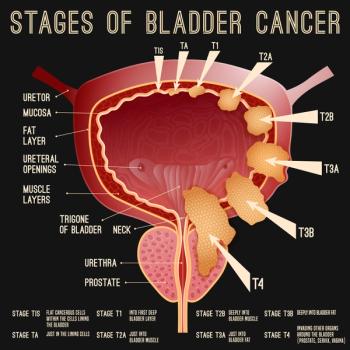
Study explores growth hormone signaling in bladder cancer
Key Takeaways
- Growth hormone receptor (GHR) signaling in bladder cancer is associated with advanced tumor stages and poor survival outcomes.
- High GHR expression in tumors up-regulates genes involved in drug resistance and invasiveness, such as drug efflux pumps and EMT programs.
Although growth hormone (GH) signaling has been connected to tumor progression and therapy resistance for multiple cancer types, its influence on bladder cancer has been largely uncharted territory.
The unknowns led researchers at Ohio University in Athens, Ohio, to investigate the impact of GH and its receptor (GHR) on therapy resistance and disease progression in urothelial carcinoma through integrated transcriptomic and in vitro analyses.
Their
First author Emily Davis, Ph.D., a clinical laboratory and genomics fellow at Nationwide Children’s Hospital in Columbus, Ohio, noted that while early-stage bladder cancer has relatively favorable outcomes, it remains challenging to treat when it becomes advanced or metastatic; patients with recurrent bladder cancer face survival rates.
That led Davis and her colleagues to ask if the pathway of GH and GHR could play a role in making bladder cancer cells resistant to therapy.
In exploring this issue, the Ohio research team turned to the massive transcriptomic database from The Cancer Genome Atlas, which holds gene expression information from hundreds of bladder cancer patients and matched normal tissues.
Among their key findings was that although tumor tissue often showed lower overall expression of GHR than adjacent normal bladder tissue, within the tumor samples themselves, higher GHR expression correlated with more advanced tumor stage and worse overall survival.
For example, patients whose tumors had above-median GHR levels had a hazard ratio of about 1.7 for worse survival compared with those below median.
Digging deeper, the researchers looked at the specific gene networks that go along with high GHR expression and discovered that tumors with high GHR tended to up-regulate genes known to be involved in drug efflux pumps and epithelial-to-mesenchymal transition programs, which enable cells to become more mobile and invasive.
The authors noted these patterns are hallmarks of aggressive and therapy‐resistant cancers.
Additionally, by examining human and mouse bladder cancer cell lines, the researchers confirmed that the cells express the GHR protein and respond to treatment with GH by activating downstream signaling molecules (such as STAT3/5, AKT, SRC).
During testing, they also treated cells with chemotherapy agents cisplatin and gemcitabine in the presence and absence of GH stimulation and in parallel with pegvisomant, a GHR antagonist sold under the brand name
On the EMT front, GH boosted expression of markers such as N-cadherin, Zeb1, Snail, Slug and Twist1, especially in cells exposed to chemotherapy.
The authors noted that bladder cancer treatment faces huge hurdles from resistance, as once cells evade chemotherapy, options are limited and outcomes are poor. Therefore, by identifying GH signaling as a contributor to therapy resistance, the study raises the possibility that blocking this pathway could improve how patients respond.
Pegvisomant is FDA-approved as a treatment for
Davis and her colleagues caution that their findings are a building block, and further in vitro and clinical studies are needed before any change in standard care should be made.
Newsletter
Get the latest industry news, event updates, and more from Managed healthcare Executive.



















































